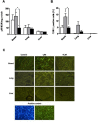Extracorporeal immune therapy with immobilized agonistic anti-Fas antibodies leads to transient reduction of circulating neutrophil numbers and limits tissue damage after hemorrhagic shock/resuscitation in a porcine model
- PMID: 20406470
- PMCID: PMC2873502
- DOI: 10.1186/1476-9255-7-18
Extracorporeal immune therapy with immobilized agonistic anti-Fas antibodies leads to transient reduction of circulating neutrophil numbers and limits tissue damage after hemorrhagic shock/resuscitation in a porcine model
Abstract
Background: Hemorrhagic shock/resuscitation is associated with aberrant neutrophil activation and organ failure. This experimental porcine study was done to evaluate the effects of Fas-directed extracorporeal immune therapy with a leukocyte inhibition module (LIM) on hemodynamics, neutrophil tissue infiltration, and tissue damage after hemorrhagic shock/resuscitation.
Methods: In a prospective controlled double-armed animal trial 24 Munich Mini Pigs (30.3 +/- 3.3 kg) were rapidly haemorrhaged to reach a mean arterial pressure (MAP) of 35 +/- 5 mmHg, maintained hypotensive for 45 minutes, and then were resuscitated with Ringer' solution to baseline MAP. With beginning of resuscitation 12 pigs underwent extracorporeal immune therapy for 3 hours (LIM group) and 12 pigs were resuscitated according to standard medical care (SMC). Haemodynamics, haematologic, metabolic, and organ specific damage parameters were monitored. Neutrophil infiltration was analyzed histologically after 48 and 72 hours. Lipid peroxidation and apoptosis were specifically determined in lung, bowel, and liver.
Results: In the LIM group, neutrophil counts were reduced versus SMC during extracorporeal immune therapy. After 72 hours, the haemodynamic parameters MAP and cardiac output (CO) were significantly better in the LIM group. Histological analyses showed reduction of shock-related neutrophil tissue infiltration in the LIM group, especially in the lungs. Lower amounts of apoptotic cells and lipid peroxidation were found in organs after LIM treatment.
Conclusions: Transient Fas-directed extracorporeal immune therapy may protect from posthemorrhagic neutrophil tissue infiltration and tissue damage.
Figures






Similar articles
-
Early Identification of Acute Lung Injury in a Porcine Model of Hemorrhagic Shock.J Surg Res. 2020 Mar;247:453-460. doi: 10.1016/j.jss.2019.09.060. Epub 2019 Oct 24. J Surg Res. 2020. PMID: 31668606
-
[Effects of different target blood pressure resuscitation on peripheral blood inflammatory factors and hemodynamics in patients with traumatic hemorrhagic shock].Zhonghua Wei Zhong Bing Ji Jiu Yi Xue. 2019 Apr;31(4):428-433. doi: 10.3760/cma.j.issn.2095-4352.2019.04.011. Zhonghua Wei Zhong Bing Ji Jiu Yi Xue. 2019. PMID: 31109415 Clinical Trial. Chinese.
-
Eight hours of hypotensive versus normotensive resuscitation in a porcine model of controlled hemorrhagic shock.Acad Emerg Med. 2008 Sep;15(9):845-52. doi: 10.1111/j.1553-2712.2008.00202.x. Acad Emerg Med. 2008. PMID: 19244635
-
Low-volume resuscitation with a polymerized bovine hemoglobin-based oxygen-carrying solution (HBOC-201) provides adequate tissue oxygenation for survival in a porcine model of controlled hemorrhage.J Trauma. 2003 Nov;55(5):873-85. doi: 10.1097/01.TA.0000092681.17874.6F. J Trauma. 2003. PMID: 14608160
-
Inhibition of neutrophil activity in cardiac surgery with cardiopulmonary bypass: a novel strategy with the leukocyte inhibition module.Perfusion. 2004 Jan;19(1):11-6. doi: 10.1191/0267659104pf709oa. Perfusion. 2004. PMID: 15072250 Review.
References
LinkOut - more resources
Full Text Sources
Other Literature Sources
Research Materials
Miscellaneous

